
How the Twitter Timeline Works (and 6 Simple Tactics to Increase Your Reach)
Product Marketing @ Buffer
Understanding the social media algorithms is important to social media marketers, especially since it can heavily impact a brand’s reach on social media. We’ve talked about the Facebook News Feed algorithm and the Instagram Feed algorithm. This time, we would love to dive into the Twitter timeline algorithm.
Up until 2015, the Twitter timeline displays tweets in the reverse-chronological order. In an attempt to improve the Twitter experience, the team at Twitter has gradually introduced changes to how they show tweets on the timeline.
In this post, you’ll learn how the Twitter timeline algorithm works and six ways to increase your reach on Twitter in 2018.
Update: It’s now possible to “turn off” the timeline algorithm by turning off “Show the best Tweets first” in your settings so that tweets from people you follow are in reverse chronological order.

How does the Twitter timeline algorithm work?
Before we dive into the specifics, it might be helpful to know that the Twitter timeline algorithm is constantly changing.
Twitter runs dozens of tests with its timeline every month. In fact, Deepak Rao, the product manager of the Twitter timeline, said, “Our algorithm changes on an almost daily to weekly basis”. As the Twitter timeline algorithm has helped to increase Twitter’s key metrics, it’s likely that Twitter will continue to test new ideas with its timeline
2.
But here’s a piece of good news: Twitter would probably not use a fully-algorithmic timeline, unlike the Facebook News Feed or Instagram feed. Jack Dorsey, CEO of Twitter, had said that Twitter will remain live and real-time
2.
Okay, let’s get into the algorithm.
The Twitter timeline algorithm

The Twitter timeline consists of three main sections:
- Ranked tweets
- “In case you missed it”
- Remaining tweets in reverse-chronological order
Every time you open the Twitter app or visit twitter.com, the algorithm will study all the tweets from accounts you follow and give each of them a relevance score based on several factors. According to Twitter and Rao, here are some of the factors
3:
- The tweet itself: its recency, presence of media cards (image or video), and overall engagement (including retweets, clicks, favorites, and time spent reading it)
- The tweet’s author: your past interactions with this author, the strength of your connection to them, and the origin of your relationship
- You: tweets you found engaging in the past, how often and how heavily you use Twitter
Then, Twitter will put the tweets that it thinks would be engaging to you in the first two sections — ranked tweets and “In case you missed it”.
The intent is to let you see the best Tweets at a glance first before delving into the lengthier time-ordered sections.Nicolas Koumchatzky, Staff Software Engineer at Twitter
Ranked tweets
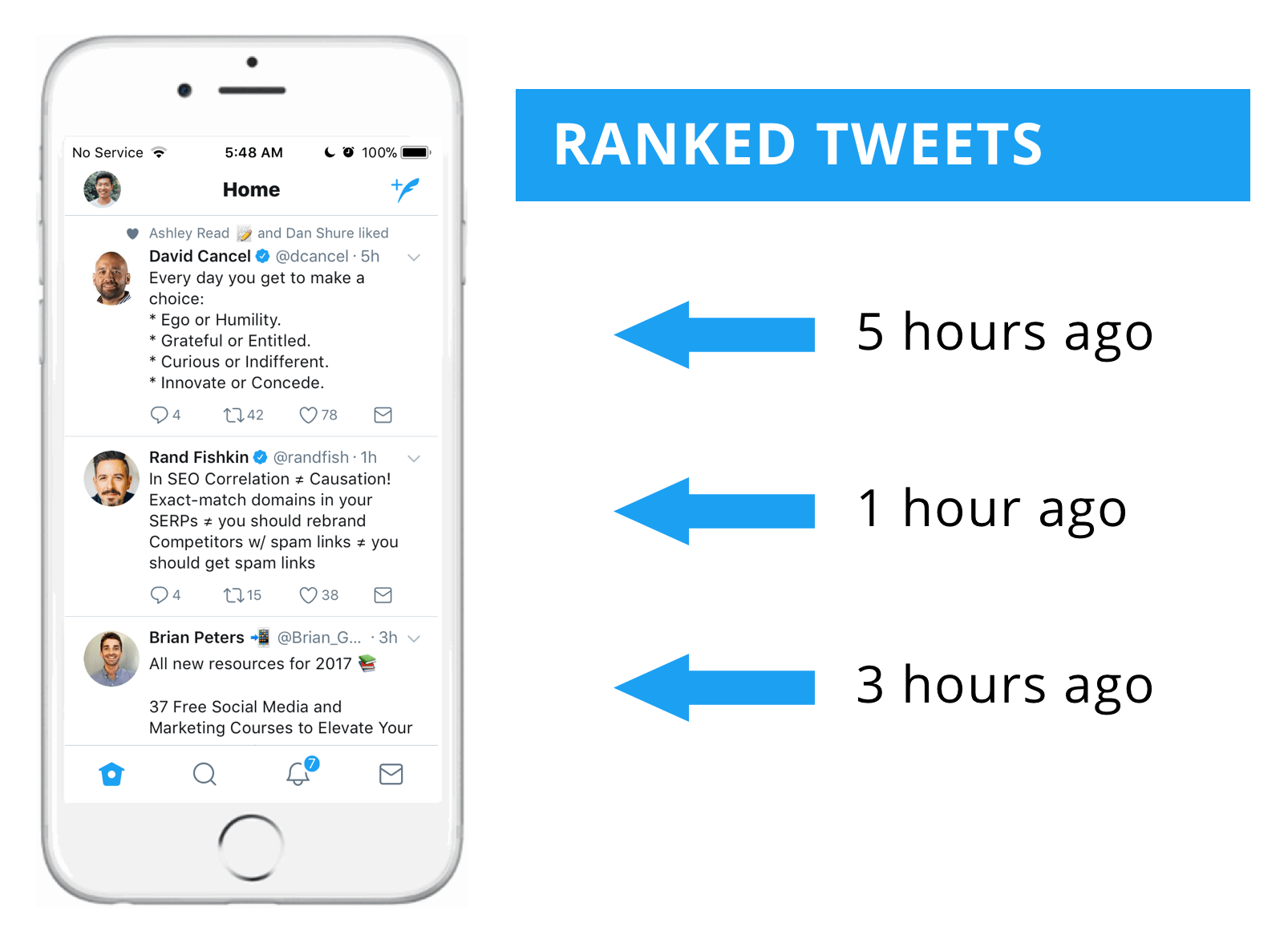
This section will appear at the top of your timeline and isn’t distinctly different from the regular timeline on first glance. But it contains only tweets that Twitter thinks are relevant to you. According to Twitter, the selected tweets should still be ordered reverse-chronologically
4. (But from my personal experience, they might not be.)
For example, in the screenshot above, the tweets were from several hours ago (when I took the screenshot). I believe this is what the algorithm did:
- It calculated that these are the tweets I might most likely be interested in,
- pulled them out from all the tweets on my timeline, and
- placed them at the top of my timeline.
Even though there were many tweets in between these tweets, the algorithm decided that these are more relevant to me than the rest. So it ranked them at the top of my timeline.
I found that these selected tweets were often liked or commented on by the accounts I follow. I believe the assumption is that if the accounts I follow interacted with these tweets, I would likely interact with them, too.
“In case you missed it”
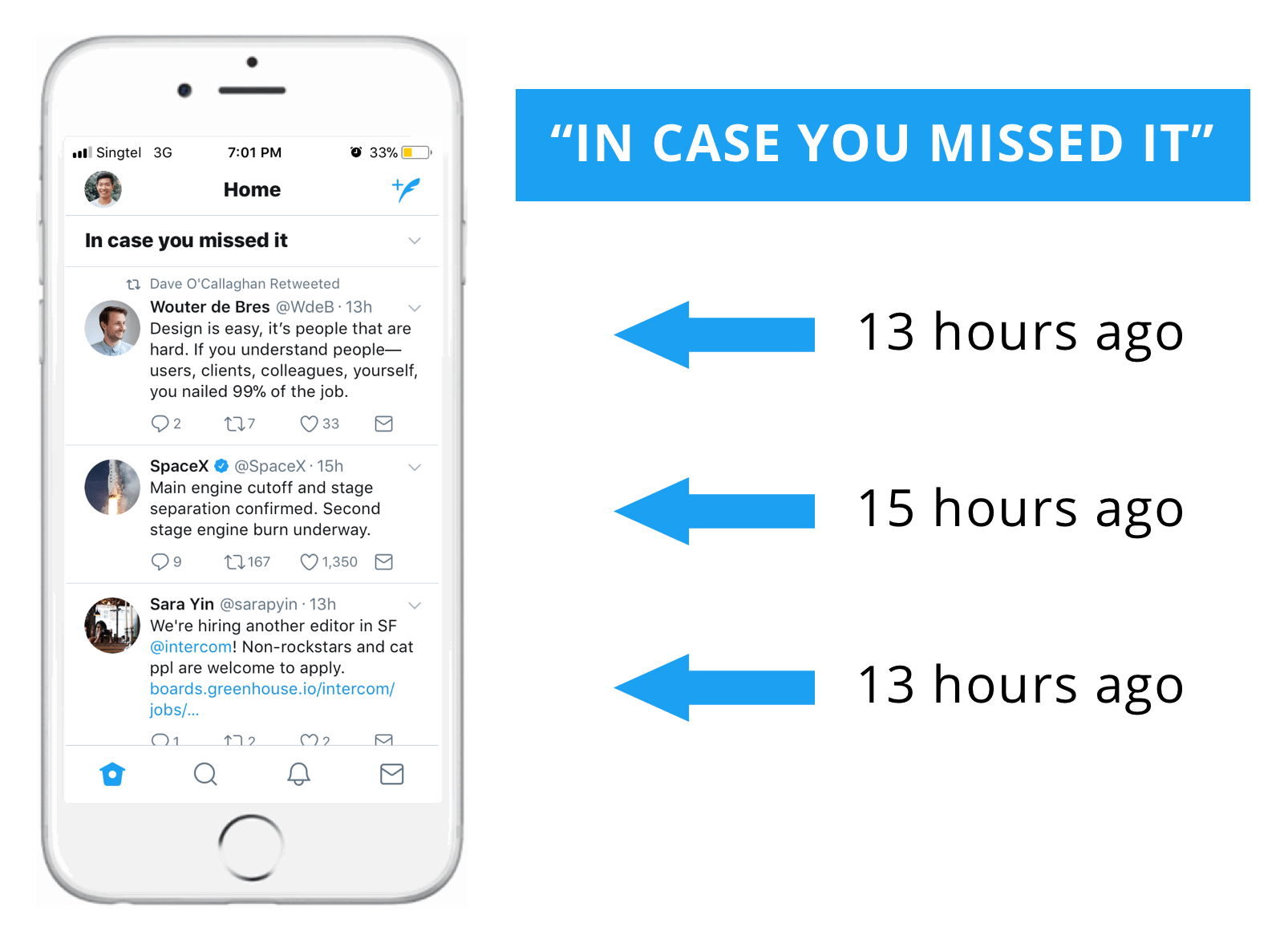
This section does as its name suggests. It shows you tweets that you might be interested in but might not see in the old timeline as they were from quite some time ago.
This module seems to only appear in your timeline when you have been away from Twitter for several hours or days
5. Similar to the ranked tweets section, this section contains tweets that Twitter thinks are relevant to you. But the selected tweets are ordered according to their relevance score and might be from many hours or days ago.
For example, as you can see in the example above, the tweets were not ordered reverse-chronologically. They were also from more than 10 hours ago — which I might not have seen if I were just scrolling through a reverse-chronological timeline.
Remaining tweets
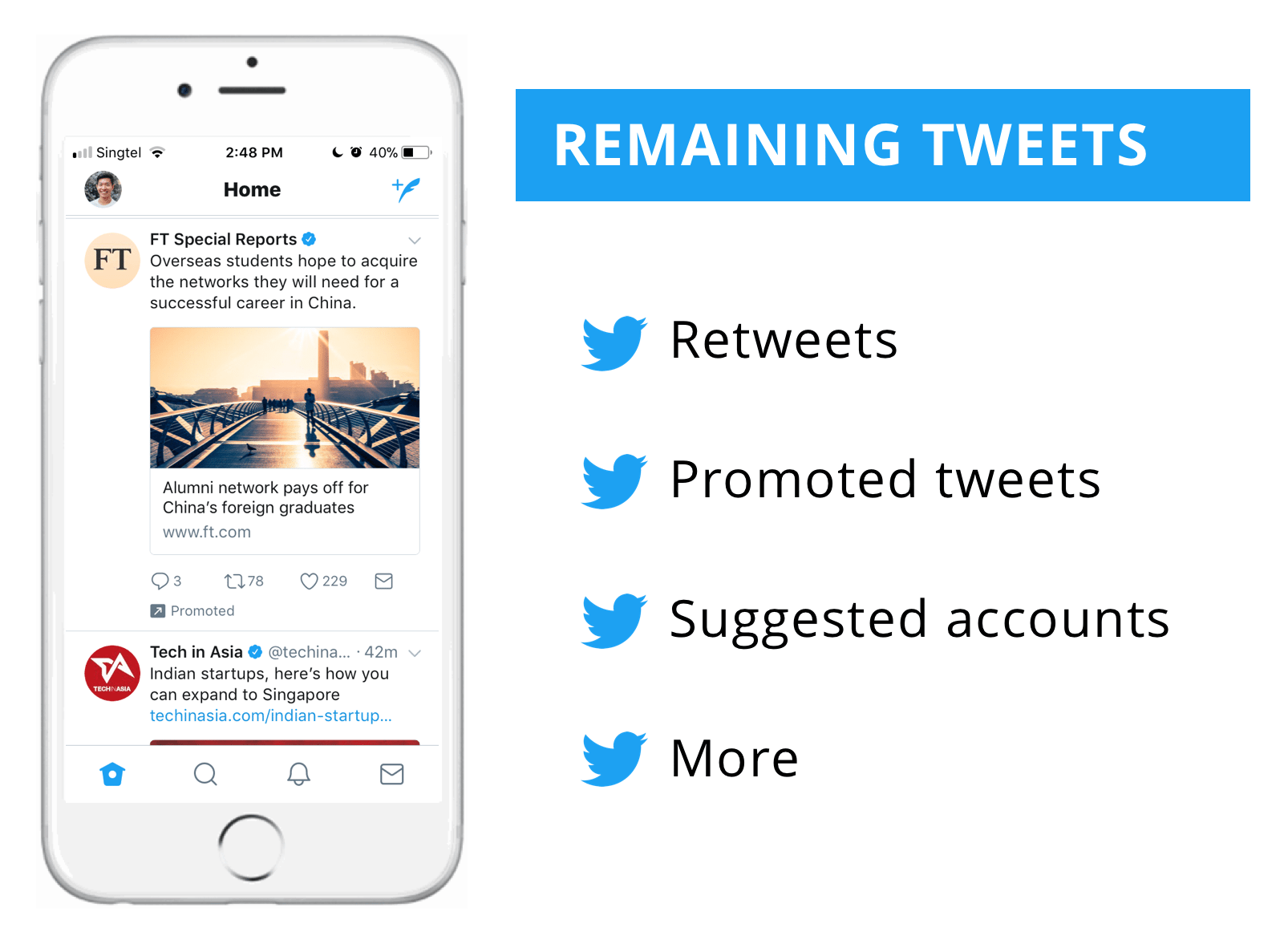
After the two sections, you’ll see the rest of the tweets from accounts you follow in the original reverse-chronological order. Just like the old Twitter timeline.
In this section (and sometimes in the two above), you’ll also find retweets, promoted tweets, and suggested accounts to follow. You might even see tweets from accounts you don’t follow. These are often tweets that Twitter thinks will make your timeline more relevant and interesting.
According to Twitter, you might also see “events featured at the top of your timeline labeled as Happening now” in the mobile app
6.
Do all these match your experience with the Twitter timeline? If not, it’ll be great to hear from you in the comments section below!

How to increase your reach on Twitter in 2018
Just like the Facebook News Feed algorithm and Instagram feed algorithm, engagement seems to be a major factor in the Twitter timeline algorithm. When your tweets receive many interactions, they would be ranked at the top of your followers’ timeline and, sometimes, even shown to people who aren’t following you.
This is a great benefit of the Twitter timeline algorithm — a ripple effect.
“It has also ensured that the most popular tweets are far more widely seen than they used to be, enabling them to go viral on an unprecedented scale.” — Will Oremus, Slate
Here’s a personal experience: Even though I only have about 2,000 Twitter followers, one of my recent top tweets has more than 11,000 impressions! That’s more than five times the number of followers I have.
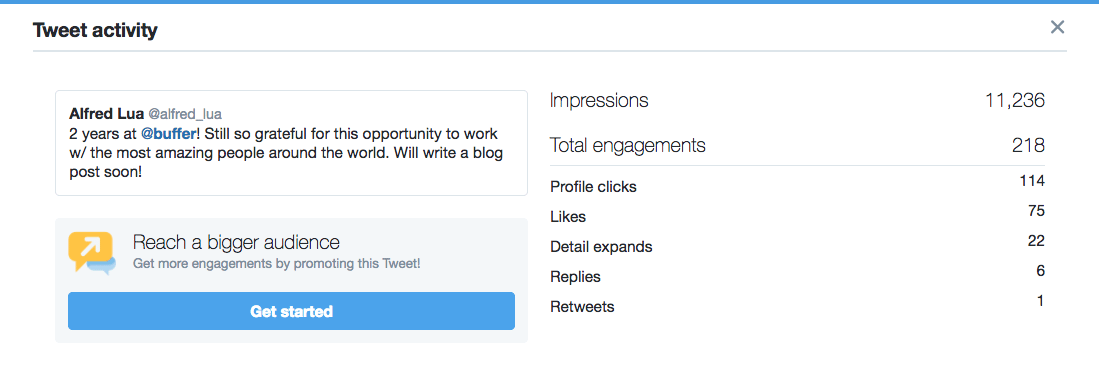
So how do you increase your Twitter reach with the new timeline algorithm?
Here are some suggestions:
1. Re-use your top posts
It’s generally accepted to tweet the same content often. Sometimes even a few times a day. Instead of re-using any tweet, choose only your top tweets. That’s because, with the help of the new timeline algorithm, popular tweets can spread further and wider.
For example, here’s a piece of content that we recently tweeted twice.
The first tweet received 162 retweets, 186 likes, and more than 51,000 impressions. The second did even better — 208 retweets, 252 likes, and more than 57,000 impressions.

With the new Twitter rules, it’ll be best to avoid tweeting the exact same content. I would recommend modifying the text or multimedia whenever you want to re-use your top content.
A way to re-use your top posts is through the analytics in your Buffer dashboard. Under the “Posts” tab, select “Most Popular” and choose your preferred timeframe.

From there, simply hit “Re-Buffer” and modify the tweet. I would recommend also sharing new content so that your followers aren’t seeing only recycled content.
If you aren’t using Buffer, you can find your top tweets in your Twitter analytics and re-publish them manually.
2. Experiment with posting times
Even though some tweets will be ranked according to the new algorithm, most tweets will be shown in the reverse-chronological order. This means that finding the best posting time is still relevant and important. When you find posting times that increase your engagement, you are also increasing your chances of your tweets being featured at the top of your followers’ timeline.
More engagement, more impressions. More impressions, more engagement.
The best way to find your optimal posting times is to experiment with various times. Twitter tools like Followerwonk and Tweriod can tell you when your followers are most active on a typical day. The most-active times are good starting points to test.
For instance, below is the breakdown of the activity of my followers.
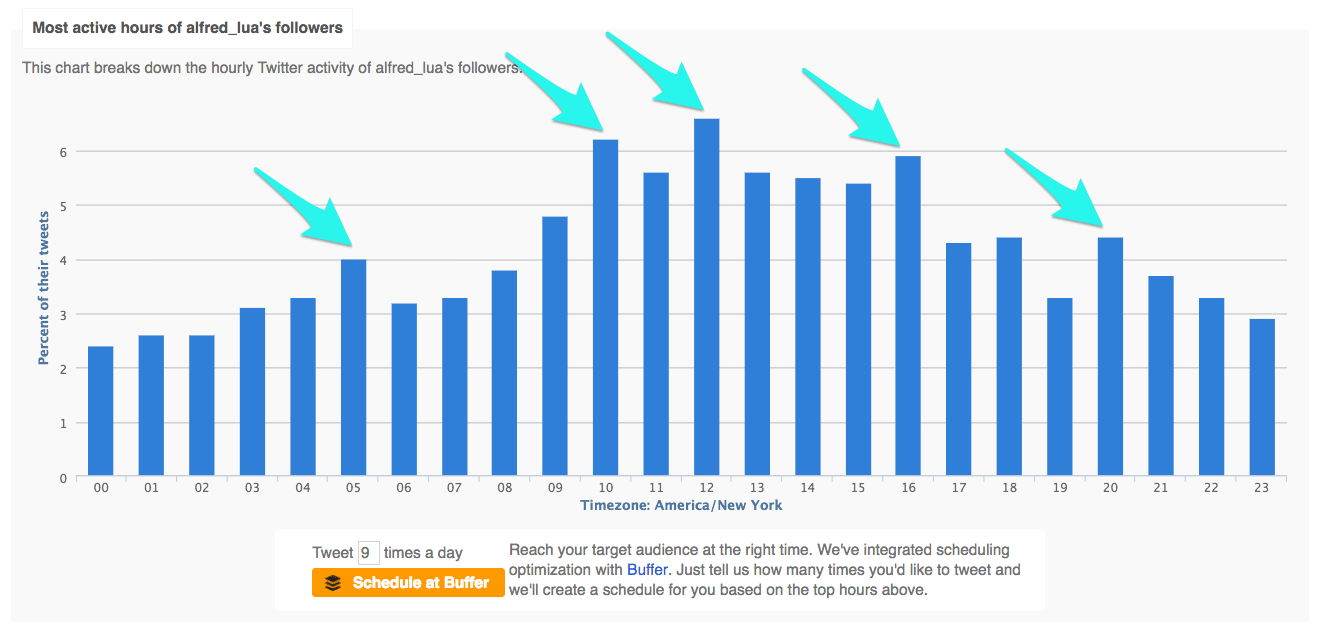
Looking at the peaks, I might start by experimenting with the following times:
- 5 am
- 10 am
- 12 pm
- 4 pm
- 8 pm
Tip: With Followerwonk, you can easily create a Buffer schedule for your Twitter account with a click of a button — Schedule at Buffer.
3. Try Twitter videos
Videos are slowly becoming the top content type. According to HubSpot’s research, videos are one of the top content types that people want to see more of in the future
7.
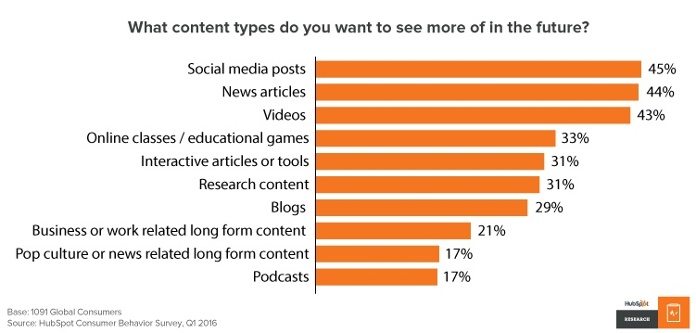
And social media platforms have been responding to this new consumption trend.
Facebook has been pushing for videos in the last few years. LinkedIn has recently introduced native LinkedIn videos. Furthermore, Twitter found that videos are six times more likely to be retweeted than photos and three times more likely to be retweeted than GIFs
8.
Here are a few quick ways you can get started with videos:
- Videos with text: If your brand has a blog, go through your Google Analytics to find your top evergreen blog posts. Then, use tools like Animoto or Lumen5 to help you easily convert your blog posts into videos.
- Recordings or interviews: You can also record yourself sharing tips (BIGVU Teleprompter can be helpful for this) or interview someone on your team.
- Live videos with Periscope: If you’re brave enough, try recording yourself live. As an example, we recently did a live Q&A on Periscope.
4. Use hashtags strategically
The hashtag was created on Twitter and remains to be an effective tactic when used appropriately. One of the best ways to use hashtags is to create branded hashtags — hashtags that are tied to your brand.
One of our branded hashtags is #bufferchat, which we use for our weekly Twitter chat. We have been using this hashtag for more than three years now. Most people in our community are familiar with it and would check the hashtag even when the Twitter chat is over. The result?
Our #bufferchat tweets sometimes get more impressions than many of our regular tweets.
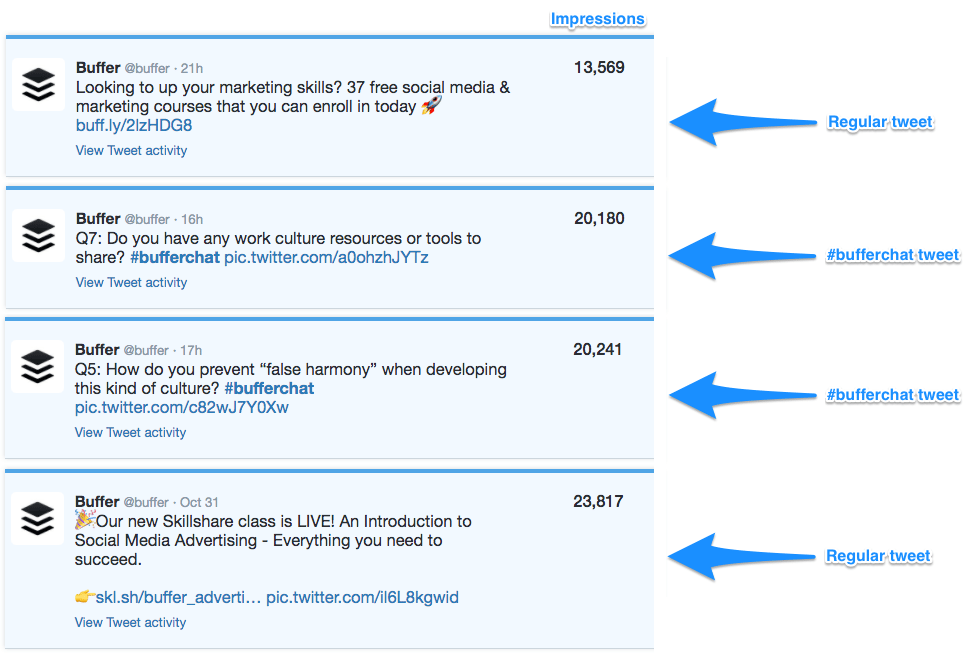
Here’s more. When people join our Twitter chat and use the hashtag, they help to increase the reach of the hashtag (and, indirectly, our brand). With the help of our awesome community, the #bufferchat hashtag reaches millions of people every week!
If you would like to start a Twitter chat, you might find these two blog posts useful:
- Twitter Chats 101: A Step-by-Step Guide To Hosting or Joining a Twitter Chat
- How to Grow a Twitter Chat to Reach 1 Million People: Learnings From Two Years of #bufferchat
5. Reply to mentions
When we think about reach and engagement, we often think about our tweets and not our replies. But that’s missing the secret reach of those replies. Replies on Twitter can receive impressions and engagement, just as if you are sharing a piece of content.
This customer support reply by Karinna was seen more than 3,000 times.

This #bufferchat reply by Arielle was seen nearly 3,000 times.

Most of our replies don’t get many impressions — about 100 to 200 each. But considering that we sent hundreds of replies every day, that can add up very quickly!
Furthermore, the new timeline algorithm seems to feature replies more prominently on your followers’ timeline if they are also following the other account.

Besides increasing your reach, it is a great Twitter practice and is beneficial to your business. In a study with more than 3,000 Twitter users, Twitter found several benefits to replying to questions from customers
9:
- People are willing to spend three to 20 percent more when the business answers their tweets.
- They are 44 percent more likely to share their experiences.
- And they are also 30 percent more likely to recommend the business.
6. Promote your tweets
As organic reach is falling, most social media platforms are becoming a pay-to-play channel. If you have some budget to spare, you could perhaps experiment with some Twitter ads.
Twitter has made it easier to boost a single tweet (just like on Facebook). Here’s how:
First, find the tweet that you want to promote. Oftentimes, tweets that have done well organically will perform even better when promoted. Click on the bar chart icon at the bottom of the tweet.
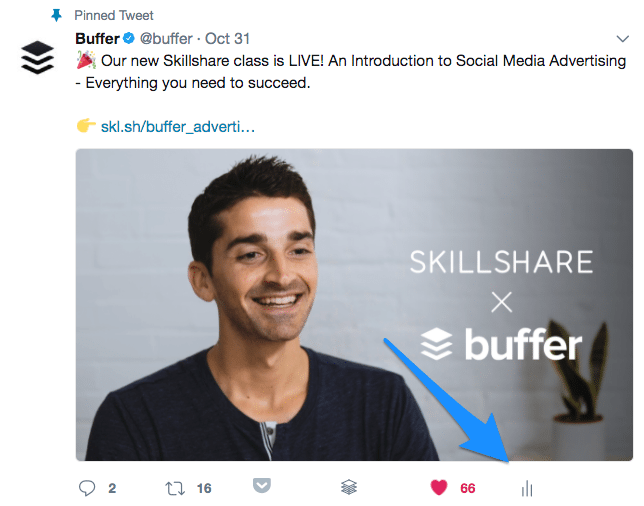
Then, click on “Promote your tweet” in the lower-left corner of the popup. You’ll be prompted to fill in your personal information and credit card details if this is the first time you’re promoting a tweet.
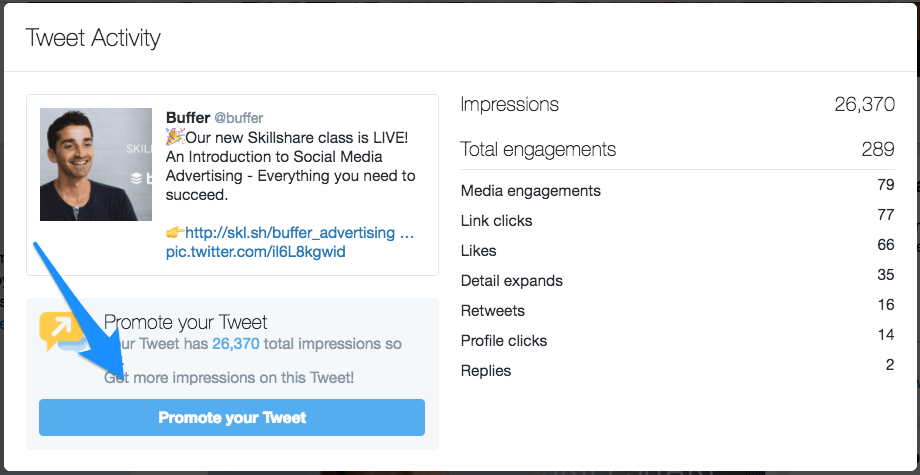
Then, set your location and budget. The location and budget options are a little limited compared with Facebook’s “Boost post”, which makes it easier to choose. If you prefer more fine-tuning, you could head over to your Twitter ads manager to create a new campaign from scratch.
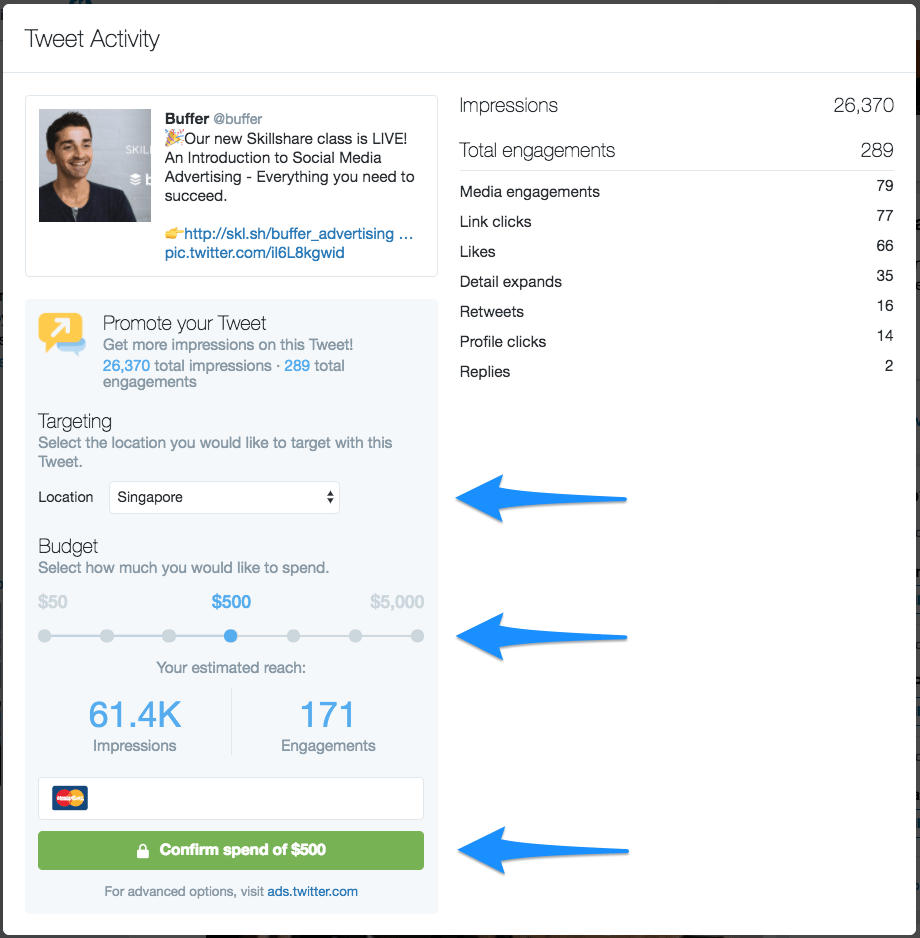
Finally, click “Confirm spend” to start your promotion. Yay!
Twitter is even testing an automated tweet promotion service. For $99 a month, Twitter will automatically amplify your tweets and profile to help you increase your reach, engagement, and following. This service is still in beta but might be opened up to brands if it goes well. (We have tested it ourselves, and here are our results!)

What’s your favorite Twitter tip?
As Twitter continues to evolve, it’s important for marketers to keep up with the changes. While the Twitter timeline might not become fully algorithmic, organic reach will continue to fall as more and more people and businesses tweet. Understanding how the Twitter timeline works can help you increase your reach and engagement.
Here are six things you could try in 2018 to increase your Twitter reach:
- Re-use your top posts
- Experiment with posting times
- Try videos
- Use hashtags strategically
- Reply to mentions
- Promote your tweets
What other Twitter tactics would you recommend us to try? Share them below and we can chat about them. Thanks!
—
Topic: Twitter marketing
The awesome featured image is by William Bout, taken from Unsplash.
Try Buffer for free
140,000+ small businesses like yours use Buffer to build their brand on social media every month
Get started nowRelated Articles

TikTok's parent company must divest the app or face a ban in the U.S. Here's everything we know, plus how to plan ahead.

Whether you’re a full-time content creator, micro-influencer, nano-influencer, or just getting started, here’s how to create your own influencer media kit.

In this article, get answers to questions about social media for solopreneurs.